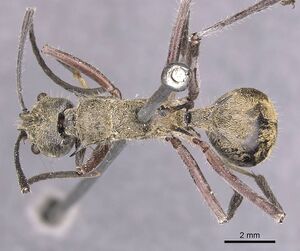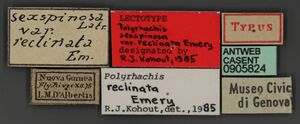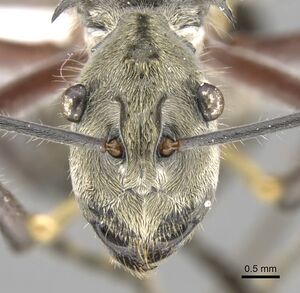Polyrhachis reclinata
| Polyrhachis reclinata | |
|---|---|

| |
| Scientific classification | |
| Kingdom: | Animalia |
| Phylum: | Arthropoda |
| Class: | Insecta |
| Order: | Hymenoptera |
| Family: | Formicidae |
| Subfamily: | Formicinae |
| Tribe: | Camponotini |
| Genus: | Polyrhachis |
| Subgenus: | Myrmhopla |
| Species: | P. reclinata |
| Binomial name | |
| Polyrhachis reclinata Emery, 1887 | |
Polyrhachis reclinata is known from lowland rainforest along the Gulf of Papua, including the Fly River delta (type locality), the lower Busu River, the Port Moresby area and Daru Island. In Australia P. reclinata has been collected from Lockerbie Scrub south to Iron Range. Most colonies collected at the latter locality were nesting within the hollow internodes of Bambusa forbesii growing as several relatively large stands within monsoon rainforest. Only a single colony of this species was located nesting under the bark of a living tree. (Kohout 2010)
Identification
A member of the Polyrhachis sexspinosa species group.
Kohout (2010) - Polyrhachis reclinata is a rather common species closely resembling Polyrhachis sexspinosa. However, they are easily separated by the following characters. The head in P. sexspinosa is strongly tapered behind the eyes and the occipital margin forms prominent, well-developed lateral lobes that are clearly visible in full face view. In addition, the vertex and sides of the head behind the eyes are rather coarsely rugose and covered with more-or-less diluted, mostly white or silvery pubescence. The propodeal spines in P. sexspinosa are virtually vertical to the main axis of the body, or are even inclined forwards when viewed laterally. In contrast, the head behind the eyes in P. reclinata is generally shorter and distinctly less strongly tapered with the lateral occipital lobes relatively weakly developed and less prominent in full face view. The sculpturation on the clypeus and sides of the head is rather smooth, with a few shallow rugae on the vertex, and is usually masked by rather dense, golden or brassy, appressed pubescence. The propodeal spines are oblique to the main axis of the body and usually curved posteriorly in side view.
The type locality of P. reclinata is the Fly River delta, which is only about 150 km from Cape York Peninsula on the opposite side of Torres Strait. Specimens from either side of Torres Strait are closely comparable, differing only in the shape and direction of spines. The pronotal spines of the specimens from the Fly River are more slender, longer and less strongly curved forwards compared to Australian specimens. The propodeal spines are almost straight while they are shorter and more strongly curved posteriorly in Australian specimens. The mesopleural process is a simple, ventrally dentiform lobe in both New Guinean and Australian specimens.
Keys including this Species
Distribution
Latitudinal Distribution Pattern
Latitudinal Range: -3.666° to -12.75°.
| North Temperate |
North Subtropical |
Tropical | South Subtropical |
South Temperate |
- Source: AntMaps
Distribution based on Regional Taxon Lists
Australasian Region: Australia.
Indo-Australian Region: New Guinea.
Distribution based on AntMaps
Distribution based on AntWeb specimens
Check data from AntWeb
Countries Occupied
| Number of countries occupied by this species based on AntWiki Regional Taxon Lists. In general, fewer countries occupied indicates a narrower range, while more countries indicates a more widespread species. |

|
Estimated Abundance
| Relative abundance based on number of AntMaps records per species (this species within the purple bar). Fewer records (to the left) indicates a less abundant/encountered species while more records (to the right) indicates more abundant/encountered species. |

|
Biology
Castes
Males and immature stages (eggs, larvae in various stages of development and pupae) in QM spirit collection.
Worker
Images from AntWeb
   
| |
| Lectotype of Polyrhachis reclinata. Worker. Specimen code casent0905824. Photographer Will Ericson, uploaded by California Academy of Sciences. | Owned by MSNG, Genoa, Italy. |
   
| |
| Worker. Specimen code casent0906759. Photographer Michele Esposito, uploaded by California Academy of Sciences. | Owned by NHMUK, London, UK. |
Nomenclature
The following information is derived from Barry Bolton's Online Catalogue of the Ants of the World.
- reclinata. Polyrhachis sexspinosa var. reclinata Emery, 1887a: 236 (w.) NEW GUINEA. Karavaiev, 1927e: 25 (q.m.). Combination in P. (Myrmhopla): Emery, 1925b: 191. Raised to species: Emery, 1911c: 259. Junior synonym of sexspinosa: Bolton, 1975c: 12. Revived from synonymy: Kohout & Taylor, 1990: 518. See also: Kohout, 2010: 192.
Unless otherwise noted the text for the remainder of this section is reported from the publication that includes the original description.
Description
Worker
Kohout (2010) - (lectotype cited first): TL c. 14.01,11.44 14.31; HL 3.48, 2.92 3.48; HW 2.37,1.89 2.37; CI 68, 62 68; SL 4.13, 3.53 4.13; SI 174, 174 195; PW 1.86, 1.56 1.86; MTL 5.09, 4.28 5.11 (23 measured).
Anterior clypeal margin arcuate, narrowly and shallowly emarginate medially; clypeus with blunt median carina, clypeus weakly convex in profile, posteriorly curving into shallow basal margin. Frontal carinae sinuate with acute, highly raised margins; central area with median longitudinal carina. Sides of head in front of eyes convex; behind eyes sides strongly tapering into narrow occipital margin with rather weakly developed occipital lobes. Eyes strongly convex, in full face view clearly exceeding lateral cephalic outline. Median ocellus usually present, lateral ocelli lacking; positions indicated by distinctly raised cephalic sculpture. Pronotal dorsum weakly convex in profile with anterior slope almost flat; humeri armed with acute, more-or-less horizontal, anterolaterally directed spines; promesonotal suture distinct. Mesopleural process a simple dentiform lobe. Mesonotal dorsum flat or weakly convex in profile. Propodeal spines long, divergent, obliquely elevated from their bases and more-or-less curved posteriorly. Dorsum of petiole with a pair of slender, widely diverging, acute spines.
Clypeus and sides of head finely reticulate-punctate, distinctly smooth; intensity of sculpturation increasing posteriorly with a few shallow rugae on vertex and towards occipital margin. Mesosoma rugose dorsally and laterally, except for relatively smooth propodeal dorsum. Gaster very finely shagreened.
Mostly yellow or pale golden hairs, of variable length and density over entire body and appendages, including antennal scapes. Relatively long, suberect, mostly golden or brassy pubescence variously developed, most dense and more appressed on dorsum of head and mesosoma where it almost completely hides underlying sculpturation. Gastral pubescence ranging from somewhat diluted on venter to dense on dorsum, where it is arranged in a characteristic midline pattern.
Body generally black; propodeum and petiole often lighter, reddish-brown; masticatory borders of mandibles, antennae and legs, including coxae, medium reddish-brown with fore coxae and tarsi distinctly darker.
Queen
Kohout (2010) - TL c. 13.55 14.46; HL 3.12 3.28; HW 1.96 2.07; CI 61 64; SL 3.83 3.88; SI 185 195; PW 2.02 2.12; MTL 4.64 4.79 (4 measured).
Differing from worker in usual characters identifying full sexuality, including three ocelli, complete thoracic structure and wings. Mesoscutum marginally wider than long with narrowly rounded anterior margin in dorsal view; median line raised; dorsum flat in lateral view with parapsides only weakly raised posteriorly. Mesoscutellum flat, not elevated above dorsal plane of mesosoma; metanotal groove distinct. Spines similar to those in worker but shorter, propodeal pair distinctly less elevated. Sculpturation, pilosity and colour virtually identical to worker.
Type Material
Kohout (2010) - Lectotype worker (by present designation) and paralectotype workers. Type locality: NEW GUINEA, Fly River, xii.75 (L. M. D’Albertis), Museo Civico di Storia Naturale, Genoa (examined).
I have examined five syntypes of the original series of P. sexspinosa reclinata, three of which were lodged in Emery’s collection and two in the separately housed main collection of the MSNG. The specimens bear the following labels: “Nuova Guinea, Fly River, xii.75, L.M. D’Albertis,” “P. sexspinosa Latr. var. reclinata Em.” and “Collezione Emery.” Besides the syntypes, I had the opportunity to examine additional specimens identified as P. sexspinosa reclinata and lodged in various other collections, however, in spite of some being furnished with a tag inscribed “Co-type,” their locality labels appeared to be of doubtful origin and not identical to those on the syntypes.
To establish the nomenclatural stability of the species and to prevent any future selection of a lectotype from outside of Emery’s original series, I have designated, in accordance with Article 74.7.3 of the International Code of Zoological Nomenclature (Fourth Edition), a syntype worker specimen as the lectotype of Polyrhachis reclinata Emery. The specimen is lodged in the Emery collection (MSNG) and, in addition to the labels listed above, it bears a red original tag inscribed “Typus.” The remaining specimens of the original series consequently become paralectotypes and are labelled accordingly.
- Polyrhachis sexspinosa reclinata Emery, 1887: Syntype, 3 workers, Fly River, Papua New Guinea, Museo Civico di Storia Naturale, Genoa.
References
- Bolton, B. 1975c. The sexspinosa-group of the ant genus Polyrhachis F. Smith (Hym. Formicidae). J. Entomol. Ser. B 44: 1-14 (page 12, Junior synonym of sexspinosa)
- Emery, C. 1887a [1886]. Catalogo delle formiche esistenti nelle collezioni del Museo Civico di Genova. Parte terza. Formiche della regione Indo-Malese e dell'Australia. [part]. Ann. Mus. Civ. Stor. Nat. 24[=(2)(4): 209-240 (page 236, worker described)
- Emery, C. 1911g. Formicidae. Résultats de l'expédition scientifique néerlandaise à la Nouvelle-Guinée en 1907 et 1909 sous les auspices de Dr. H. A. Lorentz. Nova Guin. 9: 249-259 (page 259, Raised to species)
- Emery, C. 1925d. Hymenoptera. Fam. Formicidae. Subfam. Formicinae. Genera Insectorum 183: 1-302 (page 191, Combination in P. (Myrmhopla))
- Karavaiev, V. 1927f. Ameisen aus dem Indo-Australischen Gebiet. III. Zb. Prats Zool. Muz. 3:3-52 [= Tr. Ukr. Akad. Nauk Fiz.-Mat. Vidd. 7:3-52]. (page 25, queen, male described)
- Kohout, R.J. 2010. A review of the Australian Polyrhachis ants of the subgenera Myrmhopla Forel and Hirtomyrma subgen. nov. Memoirs of the Queensland Museum – Nature. 55:167-204.
- Kohout, R. J.; Taylor, R. W. 1990. Notes on Australian ants of the genus Polyrhachis Fr. Smith, with a synonymic list of the species (Hymenoptera: Formicidae: Formicinae). Mem. Qld. Mus. 28: 509-522 (page 518, Revived from synonymy of sexspinosa)
References based on Global Ant Biodiversity Informatics
- Chapman, J. W., and Capco, S. R. 1951. Check list of the ants (Hymenoptera: Formicidae) of Asia. Monogr. Inst. Sci. Technol. Manila 1: 1-327
- Emery C. 1886. Saggio di un catalogo sistematico dei generi Camponotus, Polyrhachis e affini. Memorie della Reale Accademia delle Scienze dell'Istituto di Bologna 5: 363-382
- Janda M., G. D. Alpert, M. L. Borowiec, E. P. Economo, P. Klimes, E. Sarnat, and S. O. Shattuck. 2011. Cheklist of ants described and recorded from New Guinea and associated islands. Available on http://www.newguineants.org/. Accessed on 24th Feb. 2011.
- Kohout R. J. 2010. A review of the Australian Polyrhachis ants of the subgenera Myrmhopla Forel and Hirtomyrma subgen. nov. (Hymenoptera: Formicidae: Formicinae). Memoirs of the Queensland Museum - Nature 55:167-204.
- Kohout R. J., and R. W. Taylor. 1990. Notes on Australian ants of the genus Polyrhachis Fr. Smith, with a synonymic list of the species (Hymenoptera: Formicidae: Formicinae). Memoirs of the Queensland Museum 28: 509-522.
- Robson Simon Database Polyrhachis -05 Sept 2014
- Viehmeyer H. 1912. Ameisen aus Deutsch Neuguinea gesammelt von Dr. O. Schlaginhaufen. Nebst einem Verzeichnisse der papuanischen Arten. Abhandlungen und Berichte des Königlichen Zoologischen und Anthropologische-Ethnographischen Museums zu Dresden 14: 1-26.
- Viehmeyer H. 1914. Ameisen aus Perak, Bali und Ceram (Hym.) (Freiburger Molukken-Expedition), gesammelt von E. Streesemann. Entomologische Mitteilungen. Berlin-Dahlem 3: 112-116.

